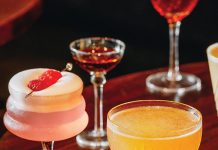I quit drinking chardonnay about five years ago. But more recently my relationship with that particular grape has been one of asking “is it safe to go in the water yet?”
Thankfully, the answer is “yes.”
Increasingly, chardonnays, many from the West Coast, are being made in what some might call “the old way.” Wines that are restrained have nice crisp acidity and make terrific food accompaniments. They have been showing up on store shelves once again. But that hasn’t always been the case.
In the 1990s and early 2000s, a sizable share of chardonnays were made as very big, full-bodied, yeasty, oaky, round, rich wines. These were also primarily sipping wines—pleasant on their own, but did not go well with food. They became good “bar pours.”
That style was associated primarily with California, though it was certainly practiced also in Australia and elsewhere. The French, and Burgundy in particular, were less apt to follow the new style and, to their credit, stuck pretty much to what they did well, such as the wines of Chablis — lean, crisp, and flinty: and great accompaniments to everything from raw oysters to poulet demi-deuil (chicken in half mourning: a roasted chicken with black truffle slices tucked all over under the skin).
The exception was the oaky new wines coming from a few mass producers in the south of France, whose business model was focused on chasing whatever the great American market liked.
This new California style was achieved by putting chardonnay through malolactic fermentation, which made it creamy, round, and soft. Detractors called it flabby and thick — almost with honey-like character. Some wines were made by full-on 100 percent “malo,” the shorthand for the process. Other wineries did malo in increments up and down the scale and blended them with regularly French-style chardonnay.
Usually, the inexpensive chardonnay was “aged” with oak chips in metal tanks, rather than in oak barrels, which are tremendously expensive. Oak imparts a mellow character and flavors such as vanilla to the wine. But chipped oak and cheaper oak also can leave a bitter flavor in the wine.
Still, the new style of chardonnay was off to the races.
While not even the upper end of these wines didn’t do well with food, they did find a home with young, newly affluent, white-collar professionals — those a little beyond entry-level wine drinkers.
The wines were mostly dull and had little identifiable character. And they were much more expensive. Labels that had sold around $15 or $18 were now $30 or $40, sometimes more.
Fortunately, the popularity for that style began to wane, helped in part by a couple of nearly disastrous bad seasons of weather. Those cooler summers in California forced winemakers to retrench and think more like Europeans, and thus make chardonnay differently. Food-friendly wines came back in style.
Today, we see a broader spectrum of chardonnay coming out of the American market, and much less of our domestic white wines are made by malolactic fermentation and oak chips. The heftiness in those wines has declined. Stylistically they are lighter and more pleasant.
Sometimes it takes a wrong turn to force a search for the better road.
|
|
|









